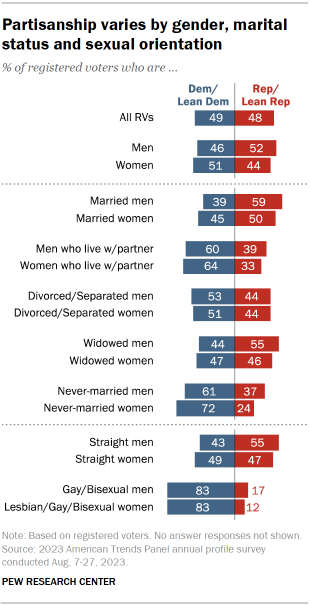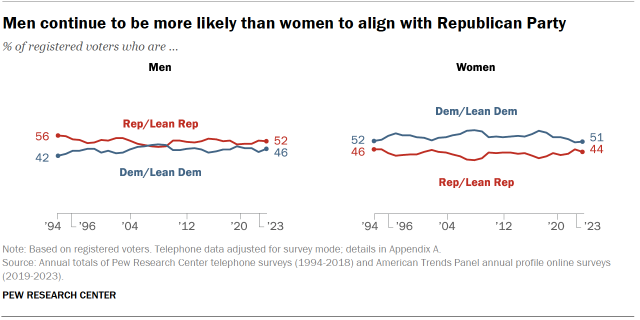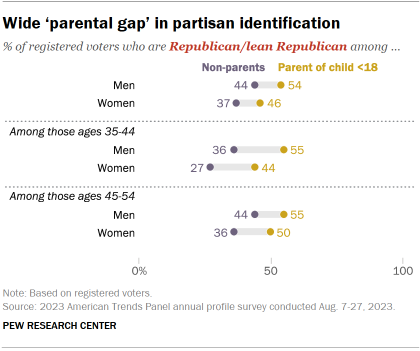Men continue to be more likely than women to associate with the Republican Party.
Partisan affiliation also varies by marital status, with gender differences in party identification apparent among married and unmarried voters.

Sexual orientation is also strongly associated with partisanship among both men and women.
- Among all registered voters, men tilt to the GOP (52% of men identify with or lean toward the Republican Party, 46% to the Democratic Party).
- By a similar margin, women tilt Democratic (51% Democratic, 44% Republican, including leaners).
Marital status
Married men and women are more likely to identify with or lean toward the Republican Party than their unmarried counterparts, with 59% of married men and half of married women oriented toward the GOP.
And while majorities of both men and women voters who have never been married and do not live with a partner align with the Democratic Party, never-married women are particularly likely to do so:
- Women who have never been married are three times as likely to associate with the Democratic Party as with the Republican Party (72% vs. 24%).
- By a narrower – though still sizable – margin (61% to 37%), never-married men also favor the Democrats.
- Democrats have a substantial advantage among both women and men who live with a partner but are not married, and a narrower edge among those who are divorced or separated.
- Widowed men tilt Republican (55% GOP vs. 44% Democratic, including party leaners), while widowed women are about equally likely to associate with the GOP or Democrats (46% and 47%).
Sexual orientation
Lesbian, gay and bisexual women overwhelmingly identify with or lean toward the Democratic Party over the GOP (83% vs. 12%). Similarly, the Democratic Party enjoys a wide advantage among gay and bisexual men (83% vs. 17%).
Straight men are more likely to associate with the Republican Party than straight women (55% vs. 47%).
Gender and partisanship
The Republican Party has held an edge among men for much of the last 30 years. Although that narrowed somewhat between 2019 and 2021, the GOP advantage has since returned.

While women have consistently been more likely to associate with the Democratic Party over the past several decades, the Democratic edge among women is narrower than it was a few years ago.
Parents are more Republican than voters without children

A slim majority (54%) of fathers of children under age 18 identify with or lean toward the Republican Party, compared with 44% of men who do not have children. There is a nearly identical gap in partisan association between mothers of minor children and women without children.
At all age levels, parents are more Republican-oriented than non-parents. For example, 55% of men ages 35 to 44 who have children under 18 identify with or lean toward the GOP. This compares with about a third (36%) of men of the same age who are not parents.




